
Technical Review
Atlas F1 Technical Writer
While the Magny-Cours was a known affair for the Formula One teams, the new Hockenheim circuit provided them with a totally new challenge from a technical point of view. Atlas F1's Craig Scarborough reviews the cars and their performance in the last two races
With the race back-to-back with the French Grand Prix, the teams were not able to test between the races and probably as a result no new technical novelties were brought to Hockenheim. Minardi announced they had a new floor and diffuser, but the differences were in detail only and the general layout was visibly unchanged.
New Layout
The circuit's new layout, with no long straights and instead focussing more on the stadium areas, was not a great challenge for the drivers to learn. Many drivers commented on how they found the circuit layout nicer than they expected, but many of the more experienced drivers bemoaned the loss of the straights and how the new track could be one of the many modern circuits that have cropped up over the past ten years, making the Grand Prix feel less like the classic German race that stood out on the calendar. Again the more experienced or wiser drivers watched the support races and in particular the F3000 race to understand which spots were genuine overtaking opportunities and where the manoeuvres could go wrong.
Teams and the tyre companies had spent a lot of time running computer simulations to establish what was needed from the cars, from this the car's baseline set-up was devised and left most of the teams fine-tuning their cars to the circuit. If the predictions for the cars basic set-up were accurate, then the predictions for the grip of the track's surface were way off. With mainly new tarmac on the track, experience suggested that the circuit would start grip-less and slippery, then get grippier as the rubber was laid down. But this increase in grip would be negated as the temperatures went up and the oil in the tarmac started to seep out.
Finding the Balance
Although the track started out slippery and dusty, many drivers found more grip than expected from a virgin track. The low grip levels were testing the tyres and inducing corner entry understeer while traction control was able to reduce the resulting power oversteer on corner exit. All the teams changed the suspension set-up to reduce the understeer and preserve the tyres. Set-up also demanded a medium level of downforce and the circuit layout proved hard on brakes and transmissions.
More grip was found in the later Friday session and again on Saturday morning, but the track went in reverse for the qualifying session, catching many drivers out. After the three opening sessions the teams predicted an improvement for qualifying and made their final tyre choices based on that prediction. All were proved wrong: it came down to the teams adaptability in altering the cars set-up to regain the loss of grip. Some teams found they had opted for the harder tyre compound and, for the conditions, this was the wrong option for qualifying. They then had to hope the race would reward the choice to regain something from the weekend. Toyota suffered and fell down the order while Ferrari kept their place and regained the pole position lost to Williams for five consecutive races despite running the harder Bridgestone compound.
In the hotter conditions for the race, the teams found the surface to alter in grip levels constantly and no driver had the car's set-up to his liking for all the stints in the race. Pit stops were used to alter wing settings and tyre pressures to tune the car to the conditions but still the teams found themselves chasing grip. There hasn't been a weekend with so many teams chasing their set-up since traction control was reintroduced last year, and all the teams found the cars behaving with similar understeer characteristics, albeit for different reasons. In the races, the long runs in the heat usually lead to the rear tyres blistering, but unusually, it was the front tyres the ones bubbling up, caused by the tyres being pushed across the tarmac in the slower corners. Again this lead the teams to alter the pit strategy to cover the loss of performance. Renault's Jarno Trulli suffered most in this respect.
With the cars proving so sensitive to the changing track conditions the weekend resulted in split fortunes for the team's drivers in every session. The lack of side by side qualifying slots and race finishes proved the teams never found most advantageous set-up, and getting the balance right was down to the driver and his race engineer fitting the car to the situation. In qualifying, despite the up and down nature of an individuals performance, the gaps between drivers were tight and a few tenths lost resulted in a bigger displacement down the grid than usual.
Reliability and Traction Control
The other issue the race presented was reliability. Slower, tighter tracks place bigger loads on the transmission and brakes, plus a hot race always reduces the reliability. Many cars retired with engine or gearbox failures when normally they had been fine. There was one last cause for a DNF or poor performance that has occurred increasingly in the past two races, which is traction control. While to most people traction control is a small piece of software running on the engine's ECU, the actual installation is much more complex. The traction control software monitors and controls many parameters of the engine, transmission and suspension.
As a result, traction control relies totally on the sensors providing it with information. Should a sensor fail to deliver the correct signal, the software cannot do its job. Some contingency is put into the software to ignore a rogue signal or use an alternative sensor, but there comes a point when there is not the required information to successfully control wheelspin. When this happens, the driver has to turn off the system and revert to driving "manually". Initially this seems like simple workaround, but the engine's driveability characteristics and the chassis' handling have been set up to capitalise on the effect of traction control, hence the driver is driving a car that is less than optimised for the conditions. Also the knock-on effect of unreliable sensors or ECU can lead to other failures in the engine and transmission.
Technical Notes from France
The French race saw the last major aerodynamic development for the Ferrari F2002 as well as a technical update for McLaren. The weekend also saw several wing failures, which appeared strange, as the circuit is almost totally smooth so bumps cannot be blamed. The race and each of the team's ultimate pace was dependant as ever on tyres and the grip the track was able to offer at any stage of the weekend.
Wing Failures
Giancarlo Fisichella had his front wing breakaway and jam underneath the car leading to a big off that left him dazed and prevented Giancarlo from any further running. The damage to the car and his helmet were testament to the severity of the impact. In the race Eddie Irvine had a rear wing failure, it appeared as though the end plates simply collapsed were they mount to the lower element, there was a similar incident for James Courtney in testing at Silverstone in July that was detected before the lurid spin that sent Eddie into retirement on Sunday could occur.
Grip and Tyres
The weekend's focus was on the grip the circuit was giving as the temperature rose and the track wore in. The circuit is synonymous with poor grip, but in reverse to the usual pattern, where the track becomes gripper over the course of the weekend, by the race's end many drivers were struggling for grip and as a result lacked traction out of the slower corners.
This was exacerbated by the late race blow-up for Allan McNish that spread oil over the track and lead to Kimi Raikkonen sliding and losing him the lead of the race. With the grip varying as the weekend wore on and the temperature rose, the tyre companies fortunes ebbed and flowed. The Michelins were working better on the McLarens than ever in the race, as the team had previously struggled to get any performance out of the French rubber. But they found themselves up on the Williams' race pace, owing to their better preservation of the softer compounds Michelin are opting for.
Aero Updates
The aero updates debuted in recent races by BAR, Jaguar, Renault and Williams were again present in France, The comprehensive and well run BAR package has brought a clear performance upgrade for the team, while the Jaguar revisions have not proven to be the Silver Bullet expected for the car. Renault's pace is in little doubt if still erratic, as it is their reliability that is hindering their results. Williams' ultimate pace is again no nearer of farther from Ferrari, and Juan Pablo Montoya is still taking pole positions even if the team find themselves undone by their tyres and pit work in the races.
Based around a revised floor and diffuser, the changes' aim was to bring more flow around the central diffuser tunnel. The outer pair of tunnels are now even more diverse in size, the inner pair now much taller and curved in to flow into the large central tunnel. To further improve this flow, the rear impact structure was changed and must have been resubmitted for crash tests. The rear light was previously horizontal and has now been rotated to sit vertically again, slimming the rear end at the expense of a higher centre of gravity, which is one of the key concepts carried throughout the F2002. At the rear there's also detail changes to the lower wing element, while the upper elements appear similar to previous Ferrari wings.
Another major element affecting the car's aerodynamics are the endplates on the front wing. These have also had major revisions: while previous versions appeared rectangular in side profile without any cut-outs, the new version has large cut-out which finds the front edge sweeping down to meet the flip-up and then follows the curve of the flip towards the rear of the endplate. This design improves the efficiency of the two-wing elements near the endplate, as fast moving air spills over to the inside of the plate energising the otherwise stagnant flow.
Team by Team
Ferrari
French GP Technical Notes
Considering the statistical records Ferrari achieved in France, the weekend was largely a straightforward one. A new aero package aimed at improving the efficiency of the underfloor was run all weekend and no other technical problems manifested themselves until race day. Again, Rubens Barrichello's car failed to leave the grid and was stranded as the rest of the field departed. Michael Schuamcher's race went uninterrupted bar the drive-through penalty; it was clear the advantage Ferrari have was narrowed in France despite the tyre problems encountered by the Michelin runners.
German GP Technical Notes
Come Sunday there were problems again for Rubens: a suspected transmission problem in his race car forced him to start in the T-car, which is now reserved for Rubens. The race went well for Rubens as he chased Ralf until, during his pitstop, the fuel flap failed to open and cost him ten seconds while the team cured the problem. Michael, as ever, raced cleanly, albeit with some problems with his first set of tyres.
Williams
French GP Technical Notes
A clean run up to the qualifying session and some outstanding driving found the Williams at the front of the grid, despite their choice of the harder Michelins tyres. The cooler race found the tyres struggling and both drivers fell back from what could have a much more competitive race. Reliability again held together and left the team looking a solution to their tyre woes that the aero update did not improve.
German GP Technical Notes
Still with the new aerodynamic rear end the Williams were best of the rest all weekend. Friday was spent running through tyre and set-up evaluations and no problems were found. In qualifying, Ralf soon found the better balance, as Juan Pablo had understeer, resulting in a second and fourth for the team. Ralf had the pace in the race but a string of problems: he was held up by Trulli, bulked by Villeneuve and finally the pressure was dropping in the engine's pneumatic valve system, obliging him to make another pitstop to have the reservoir repressurised to ensure an eventual third place finish. Juan Pablo was off the pace in the race and a cleaner run than Ralf and Rubens led to second on the podium.
McLaren
French GP Technical Notes
Overall, another improved weekend for them. The unseen changes to the car were believed to be a revised gearbox and rear end to further improve the team's use of the tyres. The grip problems produced oversteer and these stayed most of the weekend despite set-up changes to combat the worst of it. In the race, initial promise lead to disappointment for the team's very high expectations: a pit exit infringement further hampered David Coulthard, whose car had somehow switched to understeer for the race. Kimi Raikkonen was competitive the entire race and kept a clean record in the pitlane, but he slid off the track on unsighted oil and lost what looked set to be a sure win.
German GP Technical Notes
Renault
French GP Technical Notes
The French squad were competitive again this weekend and fell neatly into place behind the top three teams. The car performed well and the grip-less track manifested itself as oversteer for the R202. As with most recent races, time was lost with an engine problem during practice and another one also led to Jarno Trulli's race retirement. Jenson Button put in a solid weekend and his three-stop strategy was rewarded with a single point.
German GP Technical Notes
Renault R202 was expected to go well here but the grip-less track found the car either low on grip or unbalanced front to rear. Jenson lost time on Saturday with a spin and engine failure, leaving him an old spec engine to qualify with. Meanwhile Jarno worked on set-up and the track conditions tended to suit the car and resulted in a encouraging eight slot on the grid.
Fortunes for the team reversed for the race, both drivers having fundamental handling problems. Jarno initially ran on the pace but his tyres were degrading faster than everyone else's and he held up many rivals as he tried to cope with his problems. His early pitstop was to rectify the situation but he got caught up in an accident with Fisichella and retired. Jenson, meanwhile, went back through the field even quicker, with differential and engine trouble, and then traction control problems which led to another engine failure.
Sauber
French GP Technical Notes
After struggling on Friday Sauber opted for the harder Bridgestone tyre compounds and accepted the penalty in qualifying pace. An otherwise trouble-free weekend and promising pace in the warm-up was turned upside down by electronics and "finger" trouble, Felipe Massa released the launch control system too early and jumped the start, his drive-through penalty doubled after a pit exit infringement and a transmission related problem led to retirement. Nick Heidfeld struggled with the gearbox electronics and despite a traction control failure he was able to bring the car home in seventh, testament to the race pace of the Sauber on Bridgestones.
German GP Technical Notes
Jordan
French GP Technical Notes
Jordan's weekend was effectively ended when Giancarlo Fisichella had his off on Saturday morning. He didn't take part in qualifying and the plan was to have a dispensation to take part in the race, but such was the severity of the crash he took no further part in the Grand Prix weekend. Up to that point the car had been working well as far as Friday's times could tell. Takuma Sato took on the lead of the team for the rest of the weekend and went well in qualifying. His race ended when he understeered off the track and beached the car in a gravel trap.
German GP Technical Notes
With Fisichella recovered from his French GP accident the team were happy at first with the car, but as the track gained grip they lost their set-up slightly. Takuma had a clean session and Giancarlo had an engine blow-up depositing oil on the track and preventing him fully assessing the car on fresh tyres. Takuma then lost time on Saturday with exhaust problems, not an uncommon problem for Jordan's Honda engine, but he still went on to post the twelfth best time, his best qualifying position to date.
Giancarlo went well on fresh tyres and also posted an excellent time that got him up to sixth. This grid slot was lost at the start when he was beaten by two other faster starting cars, his pitstop then went awry with a stubborn wheel nut and clutch trouble, before he suffered his second Honda engine failure of the weekend. Sato's weekend continued to go well despite deteriorating handling later in the race and again posted his best result with eighth in the race.
BAR
French GP Technical Notes
The team openly admitted France would be a struggle for them, and they were right, both drivers suffering more than most with a lack of grip. Changes to the car brought little improvement in qualifying. A New Honda engine improved matters and one version was run in the race, which failed after 35 laps for Jacques Villeneuve. Olivier Panis was involved in a first corner accident and later had to retire with damage to the car.
German GP Technical Notes
Right from the start, Olivier found the car suited to the track, he was able to be consistent and despite a gearbox problem he finished a satisfying 12th. Jacques spent more time adjusting the car to the track and lost out on ultimate laptime to Olivier, but had more track time to evaluate tyres. With a new spec Honda for qualifying, Olivier made the most of his car and posted a superb seventh, while Jacques got caught in traffic to post a slower time back in 11th. A failure in Honda's new spec engine led to retirement for Olivier and yet more gearbox maladies forced Jacques out.
Jaguar
French GP Technical Notes
Improvements have been made to the car following testing at Monza. On Friday, both drivers enthused that this was the best car had felt all year and after an encouraging qualifying the team remained upbeat, even if they tempered this with knowledge that the times were set with the new CR4 qualifying engine and that Michelins had been working very well in the session. In the race Eddie's wing failure cost him a competitive run and Pedro de la Rosa's race was interrupted by an off-track moment and a pitstop for checks to the rear wing.
German GP Technical Notes
The team split their tyre choices on Saturday. Eddie suffered from mid-corner understeer, and this penalty pushed him down the grid more than he expected. Pedro was on the harder tyres and this also penalised him with a poor 20th slot on the grid. The teams woes continued into the race with Eddie suffering traction control problems leading to two spins and then a brake problem forced him to retire. Pedro's race lasted only one lap when he lost all drive as he changed into seventh gear on the back straight.
Toyota
French GP Technical Notes
So much is expected from the Toyota team. A lot has been delivered but their weekend was again ruined by the car's lack of rear end grip. Both drivers struggled for grip and more importantly traction all weekend. Rear suspension and traction control changes were tried and progress was made but the team tailed the midfield and also had technical problems mainly afflicting Mika Salo over the weekend. His problem on Friday was matched with identical engine failures for both drivers in the race.
German GP Technical Notes
Having never ran at either the new or old tracks, Toyota split their drivers programmes for Friday, which left Allan McNish a promising ninth and feeling the car was suited to the track, while Mika had an electronic problem, but he felt confident for the weekend. Saturday brought problems for the team, with the track's grip level altering for qualifying the team could not react to the conditions and the car lost its balance and consistency.
In the race, Mika found the car oversteering on the first set of tyres and he made front wing adjustments during the pitstop. He continued for a reliable run to the end. Allan had a better start and jostled with others drivers, climbing up the order until his first stop, when leaving the pits the cars hydraulics failed and leaked, leading to a dramatic fire.
Minardi
French GP Technical Notes
Not expecting to able to get the best from the car on the tricky track, Minardi actually found themselves overperforming in comparison to many teams. Pressure problems both in the hydraulic and fuel circuits slowed progress. An aggressive race strategy and reliability found the team with an unexpected and respectful 8th and 10th in the race.
German GP Technical Notes
Webber felt he made the most of the car in qualifying to set the 21st quickest time and what was to be last. Yoong failed to post a time within 107% and was almost two seconds slower than his teammate. With Webber the sole Minardi on the starting grid, he left last and well behind due to a launch control problem. He was on the pace and up with his competitors when a leaking hydraulic seal forced him into retirement.
Arrows
French GP Technical Notes
Financial and not technical problems prevented the team from running in France. The hugely promising A23 looks to be suffering from lack of development and the perennially hard working Arrows team's future is in much doubt.
German GP Technical Notes
Technical Notes from Germany
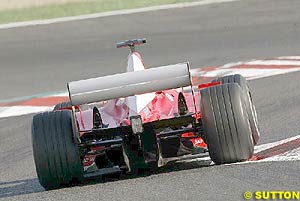 To add to the aero updates, Ferrari brought what at first appeared simple revisions to the front and rear wings but was, in fact, a massive upgrade to the car and resulted several major components being redesigned. The F2002 has gone further to slim the rear end than any other car this year: the packaging of the rear suspension, exhausts and cooling outlets all lead to a dramatically waisted coke bottle shape that improves flow over the floor, around the diffuser and to the rear wing. The lower engine cover introduced a few races ago improved this, and changes ran in France further reduced the cross section of the rear end.
To add to the aero updates, Ferrari brought what at first appeared simple revisions to the front and rear wings but was, in fact, a massive upgrade to the car and resulted several major components being redesigned. The F2002 has gone further to slim the rear end than any other car this year: the packaging of the rear suspension, exhausts and cooling outlets all lead to a dramatically waisted coke bottle shape that improves flow over the floor, around the diffuser and to the rear wing. The lower engine cover introduced a few races ago improved this, and changes ran in France further reduced the cross section of the rear end.
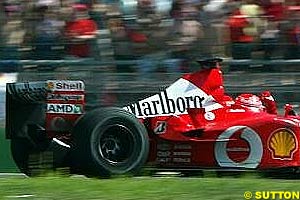 With the French aero package still in place the car was otherwise unchanged for Germany, only the optional cooling outlets on the sidepods being opened up for the race. Both drivers went fastest on Friday, with no technical or handling problems reported. Still with no complaints in the qualifying session, both drivers made some errors on their runs, but it didn't stop them from getting pole and third for the team. Meanwhile, Ferrari demonstrated their resources and the benefit of a private testing track at Fiorano as Luca Badoer tested some revised electronics in a F2002, which were to be used for the race.
With the French aero package still in place the car was otherwise unchanged for Germany, only the optional cooling outlets on the sidepods being opened up for the race. Both drivers went fastest on Friday, with no technical or handling problems reported. Still with no complaints in the qualifying session, both drivers made some errors on their runs, but it didn't stop them from getting pole and third for the team. Meanwhile, Ferrari demonstrated their resources and the benefit of a private testing track at Fiorano as Luca Badoer tested some revised electronics in a F2002, which were to be used for the race.
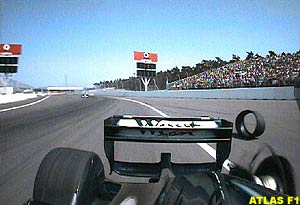 As a second home GP for the Mercedes-powered team, the weekend started well, with only a floor-damaging trip off the circuit for Coulthard. Qualifying tested the car and its tyres more, leaving the team unable to cope with the changing conditions. Coulthard made some driving errors dropping him down the grid, while Raikkonen came out on top. Kimi also starred in the race, getting ahead of Juan Pablo Montoya's Williams to begin with, then defending for several laps until the faster Williams came past for good. He kept his pace until a rare puncture forced him into the pits, but the rear brake duct was damaged from the flailing tyre and the Finn eventually retired when he went off the track. David suffered with blistering tyres and made changes in his first pit stop to counteract the problem, allowing to run well in the middle stint and to a final fifth pace.
As a second home GP for the Mercedes-powered team, the weekend started well, with only a floor-damaging trip off the circuit for Coulthard. Qualifying tested the car and its tyres more, leaving the team unable to cope with the changing conditions. Coulthard made some driving errors dropping him down the grid, while Raikkonen came out on top. Kimi also starred in the race, getting ahead of Juan Pablo Montoya's Williams to begin with, then defending for several laps until the faster Williams came past for good. He kept his pace until a rare puncture forced him into the pits, but the rear brake duct was damaged from the flailing tyre and the Finn eventually retired when he went off the track. David suffered with blistering tyres and made changes in his first pit stop to counteract the problem, allowing to run well in the middle stint and to a final fifth pace.
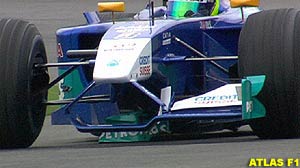 Friday split the drivers, with Nick not finding enough grip and Felipe much happier despite a few excursions, in on of which and he spun on oil from Fisichella's Honda engine, damaging his front wing. Qualifying reversed the order and fortunes: Nick suffered hydraulic failure in his race car but managed to lap quicker in his T-car; Felipe lost the grip he found on Friday and was unable to make real use of the fresh tyres in qualifying. The race brought equal fortunes with both drivers in the hunt for points, with Heidfeld eventually gaining the point for sixth despite a trip across the grass.
Friday split the drivers, with Nick not finding enough grip and Felipe much happier despite a few excursions, in on of which and he spun on oil from Fisichella's Honda engine, damaging his front wing. Qualifying reversed the order and fortunes: Nick suffered hydraulic failure in his race car but managed to lap quicker in his T-car; Felipe lost the grip he found on Friday and was unable to make real use of the fresh tyres in qualifying. The race brought equal fortunes with both drivers in the hunt for points, with Heidfeld eventually gaining the point for sixth despite a trip across the grass.
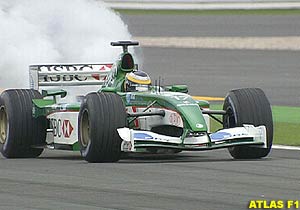 For Eddie, Friday went cleanly with a reasonable balance from the car, but Pedro suffered a Cosworth engine failure, losing him time to work on the set-up time.
For Eddie, Friday went cleanly with a reasonable balance from the car, but Pedro suffered a Cosworth engine failure, losing him time to work on the set-up time.
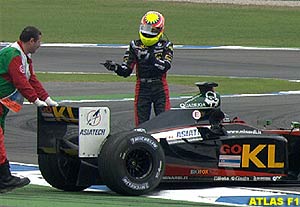 It was a tough first day for the team, with Alex Yoong beaching his car and losing a lot of track time. Mark Webber, meanwhile, worked through his programme despite a gearbox issue.
It was a tough first day for the team, with Alex Yoong beaching his car and losing a lot of track time. Mark Webber, meanwhile, worked through his programme despite a gearbox issue.
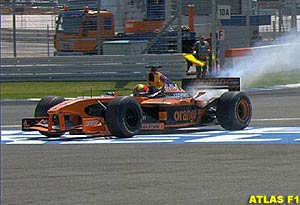 Happy to be fully participating in a race weekend again, the team brought an unchanged specification car to Germany. Diligently working through thier Friday programme, the drivers soon found a good balance and were placed tenth and eleventh. The balance was harder to maintain on their chosen tyres for Saturday and the team lost out in qualifying, Heinz-Harald Frentzen and Enrique Bernoldi dropping five and eight places respectively. Race day brought familiar failures for the Arrows, Frentzen stalling on the grid and ultimately suffering a hydraulic leak while Enrique had another Cosworth engine failure 48 laps into the race.
Happy to be fully participating in a race weekend again, the team brought an unchanged specification car to Germany. Diligently working through thier Friday programme, the drivers soon found a good balance and were placed tenth and eleventh. The balance was harder to maintain on their chosen tyres for Saturday and the team lost out in qualifying, Heinz-Harald Frentzen and Enrique Bernoldi dropping five and eight places respectively. Race day brought familiar failures for the Arrows, Frentzen stalling on the grid and ultimately suffering a hydraulic leak while Enrique had another Cosworth engine failure 48 laps into the race.
Please Contact Us for permission to republish this or any other material from Atlas F1.
|
Volume 8, Issue 31
Atlas F1 Special
Atlas F1 Exclusive
The Complexities of Ralf Schumacher
Coulthard's Fighting Talk
Jo Ramirez: a Racing Man
German GP Review
2002 German GP Review
French & German GP Tech Review
Adapt or Die
Stats Center
Qualifying Differentials
SuperStats
Charts Center
Columns
Season Strokes
Elsewhere in Racing
The Grapevine
> Homepage |